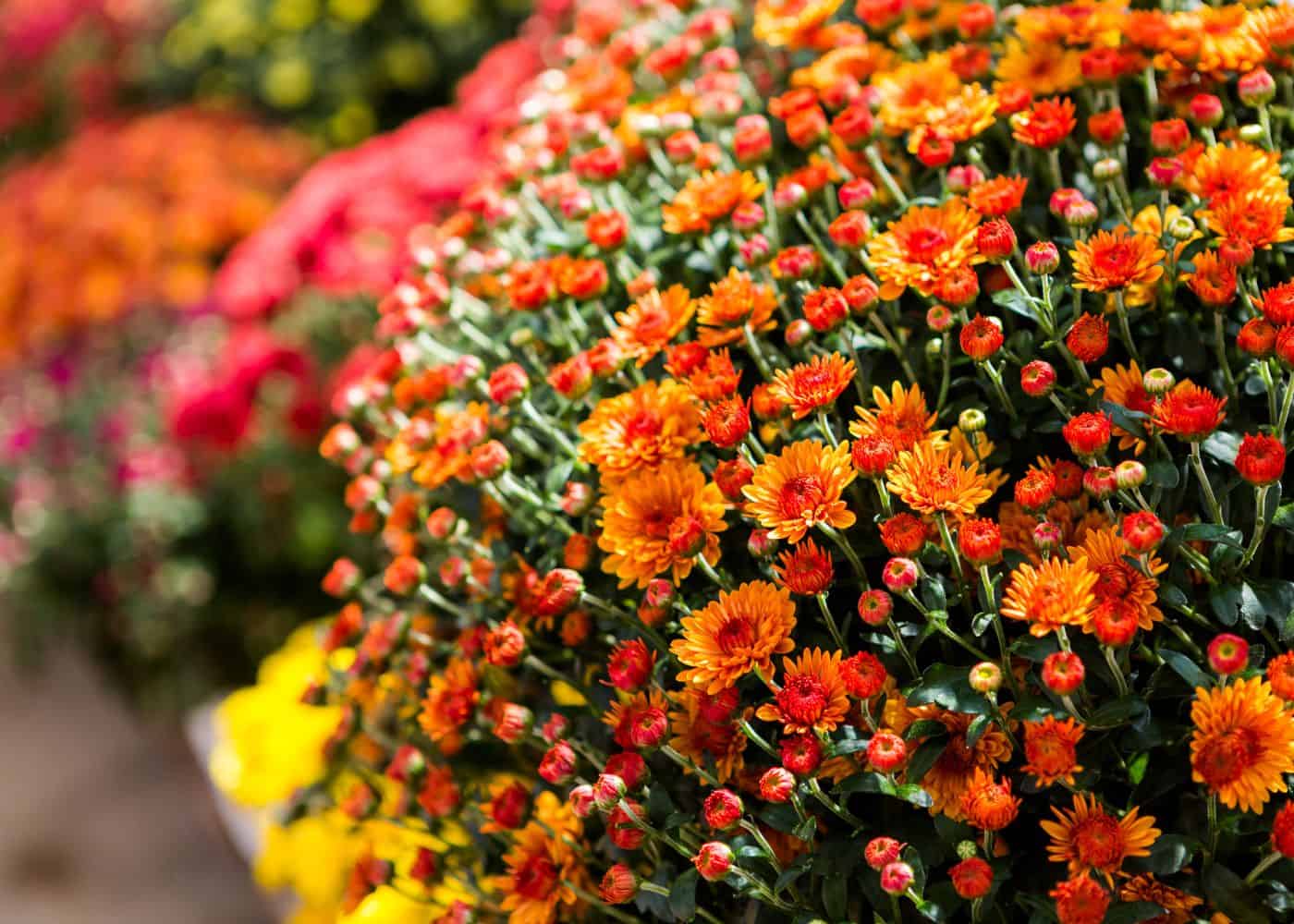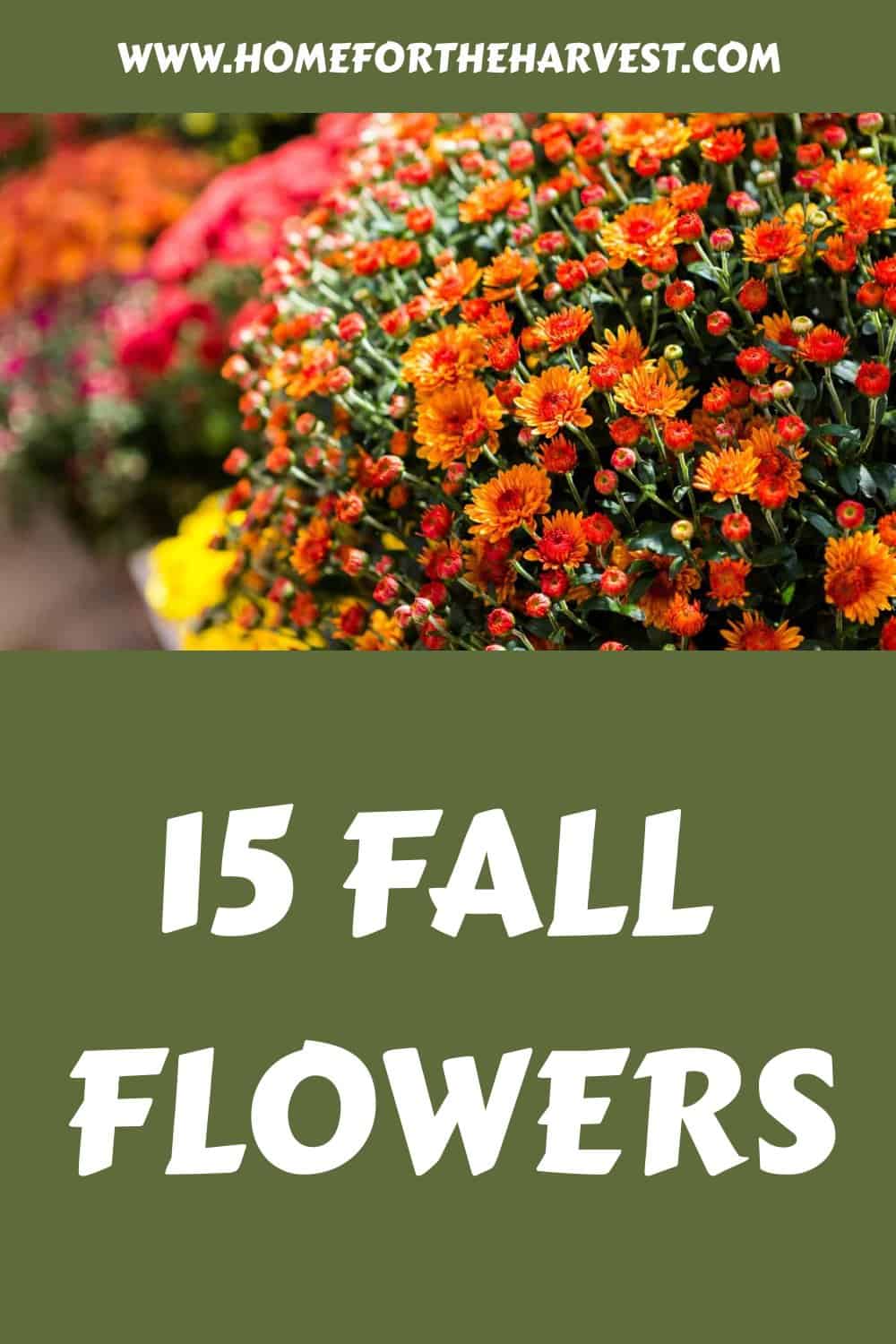As the leaves begin to change and the air turns crisp, many gardeners start packing away their tools, thinking the season for vibrant blooms has passed. But fall doesn’t have to signal the end of your colorful garden display; it can be a new beginning! From the rich, warm hues of mums to the striking elegance of late-blooming roses, fall flowers offer a stunning array of options to keep your garden glowing right into the cooler months.
1. Fall mums
Fall mums are synonymous with autumn and are beloved for their rich, vibrant colors and dense, dome-shaped blooms. These perennials burst into a spectacular display of color—ranging from shades of red, orange, and yellow to purples, pinks, and even whites—just when most other garden plants are winding down for the year. Their ability to withstand cooler temperatures and shorter days make them a popular choice for adding a splash of enduring color to fall gardens, patios, and indoor settings.
When it comes to cultivars, there are hundreds to choose from, but some popular ones include ‘Clara Curtis’ (pink), ‘Hillside Sheffield Pink’ (soft apricot-pink), and ‘Jackie’ (deep orange). These plants prefer well-drained soil and a sunny location, although they can tolerate partial shade. Mums are relatively low-maintenance but do best when planted in the spring to allow their root systems to establish well before winter. However, if you’re planting them in the fall, make sure to do so well before the first frost to give them the best chance at survival. They also benefit from regular deadheading to encourage more blooms and a more compact shape.

2. Sunflower
Sunflowers are iconic flowers that bring cheer and warmth into any setting. While they are often associated with summer, some late-blooming varieties can extend into the fall, adding bursts of yellow, orange, and even red to the garden. Characterized by their large, round faces and bright petals, sunflowers can range in size from small, bushy plants to towering giants that can reach up to 12 feet in height. Their ability to thrive in a variety of soil types and conditions makes them a versatile and resilient choice for many gardeners, especially those looking to add a touch of sunny optimism to their fall gardens.
Popular sunflower cultivars that are well-suited for fall include ‘Autumn Beauty,’ which offers a mix of warm colors, and ‘Evening Sun,’ with its rich, reddish-brown tones. For smaller gardens or container planting, ‘Elf’ and ‘Teddy Bear’ are dwarf varieties that take up less space but are big on charm. Sunflowers prefer full sun and are fairly drought-tolerant, making them an ideal choice for areas with less reliable rainfall. They do best in well-drained soil enriched with compost or other organic matter. Given their straightforward needs and striking appearance, sunflowers are often a hit with both beginner gardeners and seasoned horticulturists alike.

3. Dahlias
Dahlias are stunning, versatile flowers that make an excellent addition to any fall garden. Known for their intricate petal arrangements and wide array of colors—from pastels to vibrant hues—they offer a striking visual feast. Dahlias come in various forms and sizes, ranging from petite border varieties to dinner-plate-sized blooms that can span up to 10 inches across. Their long-lasting flowers make them a popular choice for both gardens and floral arrangements, and their blooming season can extend well into fall, providing a colorful display when many other plants are starting to fade.
Popular dahlia cultivars suitable for fall gardens include ‘Café Au Lait,’ with its creamy, blush-colored petals, ‘Mystic Dreamer,’ known for its deep pink flowers and dark foliage, and ‘Bishop of Llandaff,’ which sports vivid red blooms and almost-black leaves. Dahlias prefer a sunny location and well-drained, moderately fertile soil. While they are not especially drought-tolerant, they do require good drainage to prevent root rot. For best results, they should be planted in the spring after the last frost, allowing the tubers to establish well before the colder seasons. However, in milder climates, they can also make a fantastic late-summer to early-fall planting, filling the garden with color just when it needs it most.
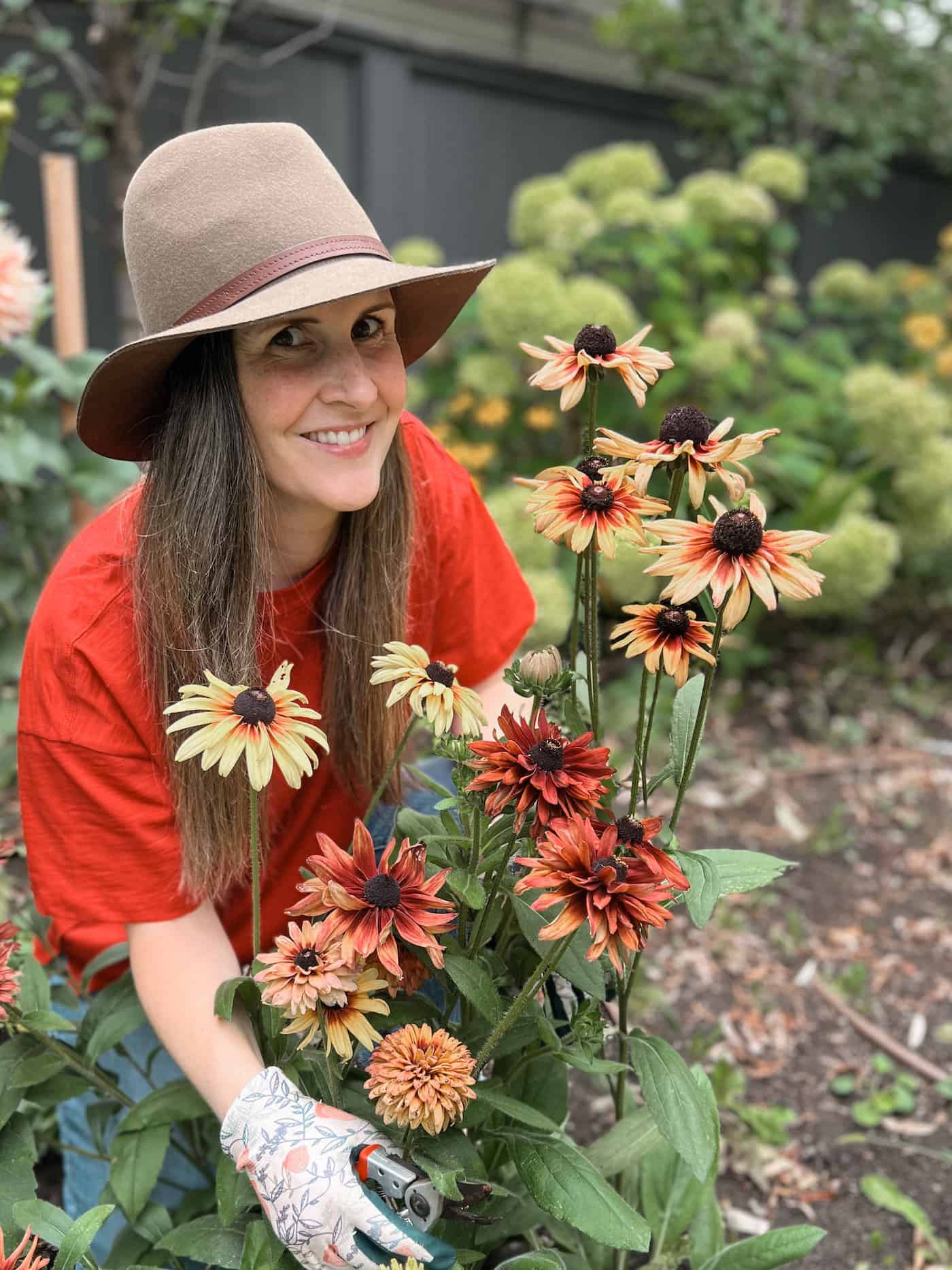
4. Black eyed Susan
Black-eyed Susans are quintessential fall flowers that bring a touch of golden yellow to gardens as the seasons change. These daisy-like blooms feature a rich, dark brown or black center, surrounded by vibrant yellow or orange petals. Ranging in height from 1 to 3 feet, Black-Eyed Susans are versatile enough to be a part of both small flower beds and large landscape plantings. With their prolonged blooming period from mid-summer through fall, these plants are excellent for providing a lasting splash of color when many other flowers have stopped blooming.
Popular cultivars include ‘Goldsturm,’ known for its golden-yellow petals and dark, almost black center, and ‘Sahara,’ which offers larger blooms of different colors. Black-eyed Susans prefer full sun but are tolerant of partial shade, making them quite versatile in the garden. They are hardy, drought-resistant, and adaptable to a variety of soil types, although they prefer well-drained soil. With their low maintenance requirements and resilient nature, Black-Eyed Susans are an excellent choice for both beginner gardeners and those looking to add some late-season color to their outdoor spaces.
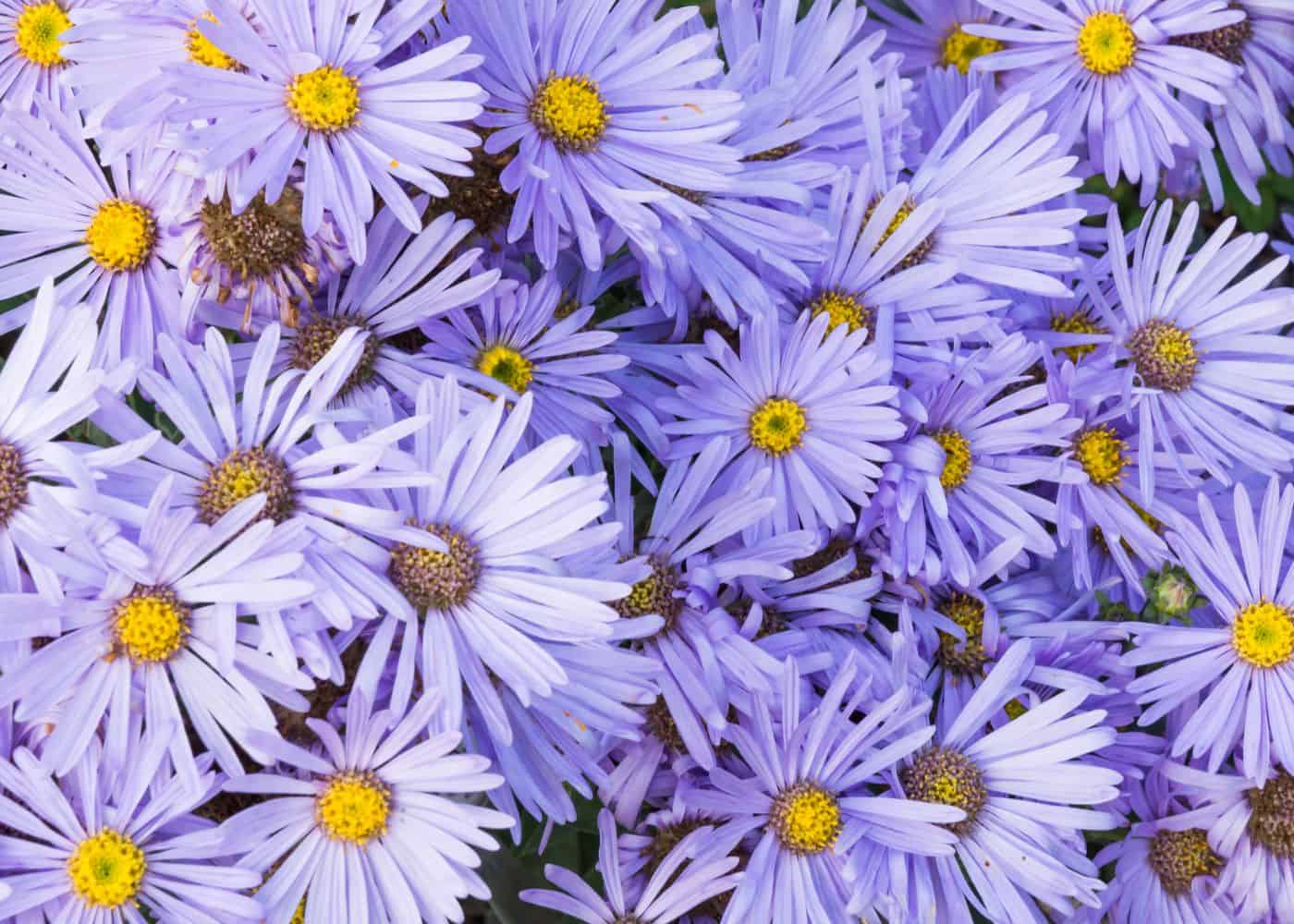
5. Aster
Asters are classic fall flowers that burst into bloom just when the garden needs a rejuvenation of color. These perennials offer a range of hues from white and pink to purple and blue, all centered around a bright yellow or gold disk. The daisy-like flowers can range from tiny, clustered blossoms to larger, singular blooms, and their height can vary from low-growing border types to taller varieties that can reach up to 4 feet. Asters are particularly popular for fall gardens because they offer late-season nectar for pollinators and create a colorful contrast to the warm, earthy tones of autumn.
Popular aster cultivars include ‘Wood’s Pink,’ which has light pink flowers and is highly resistant to mildew, and ‘Purple Dome,’ known for its deep purple color and more compact growth habit. For ideal growing conditions, asters prefer full sun but can tolerate light shade. They are best suited for well-drained soil, enriched with organic matter. Asters are relatively drought-tolerant once established, but they’ll perform best with consistent moisture. Given their late-blooming nature, they pair beautifully with other fall favorites like chrysanthemums and ornamental grasses to create a multi-seasonal garden landscape.
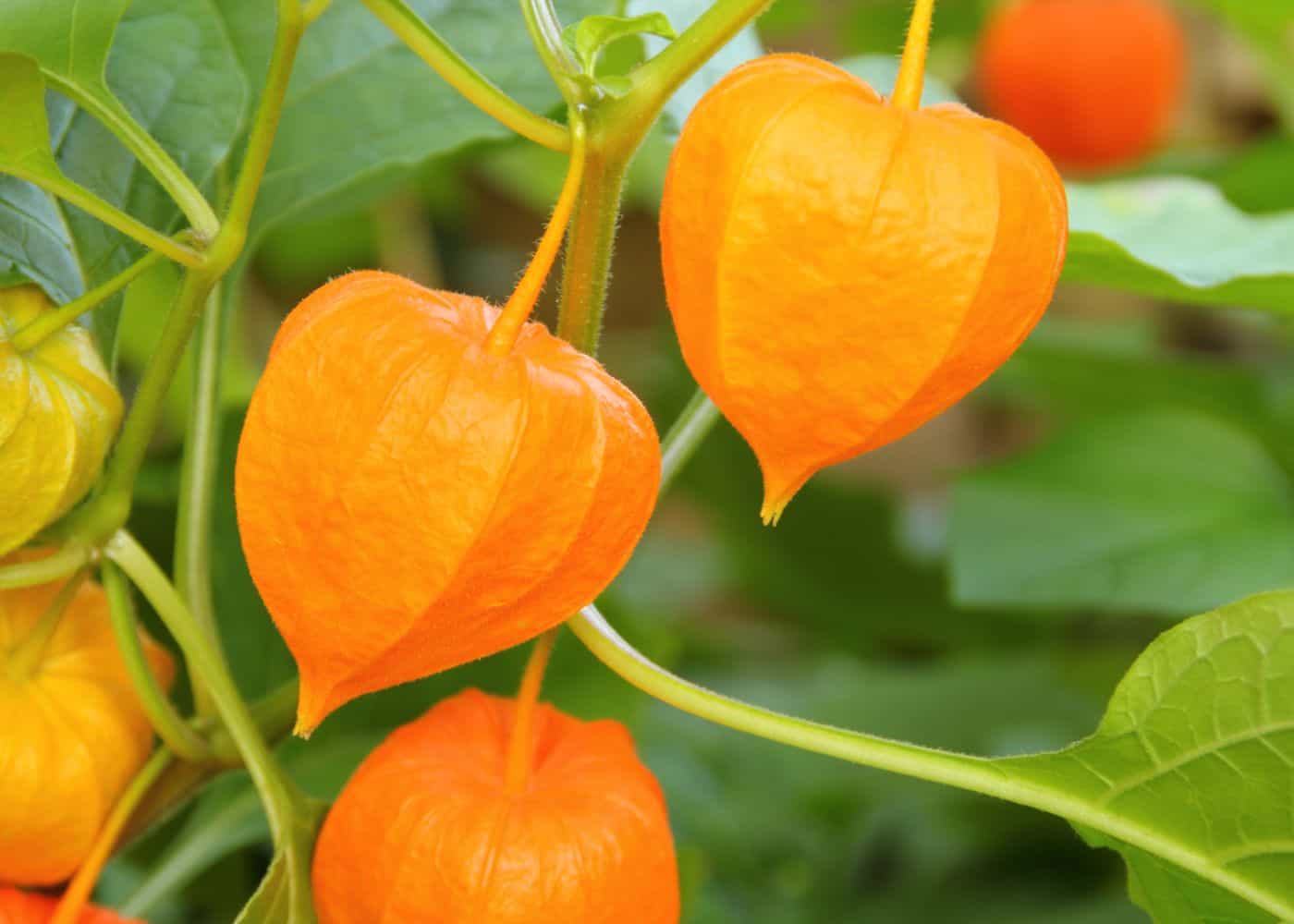
6. Chinese lantern
Chinese lantern (Physalis alkekengi) is a unique and eye-catching addition to the fall garden. Known for its brilliant orange-red, lantern-shaped calyces that encase small berries, this plant offers a whimsical and exotic touch. As other plants start to fade away in the fall, the Chinese lantern plant comes into its own, providing strong visual interest and often serving as a focal point in autumn-themed arrangements or dried flower crafts.
The plant is best suited for well-drained, loamy to sandy soil and prefers full sun to partial shade. It’s a hardy plant that can adapt to less-than-ideal conditions, including poor, dry soils. However, it’s important to note that the Chinese lantern plant can be invasive and may require containment or regular thinning. Once established, it’s a low-maintenance plant, resistant to most pests and diseases, making it a charming and durable option for fall gardens.
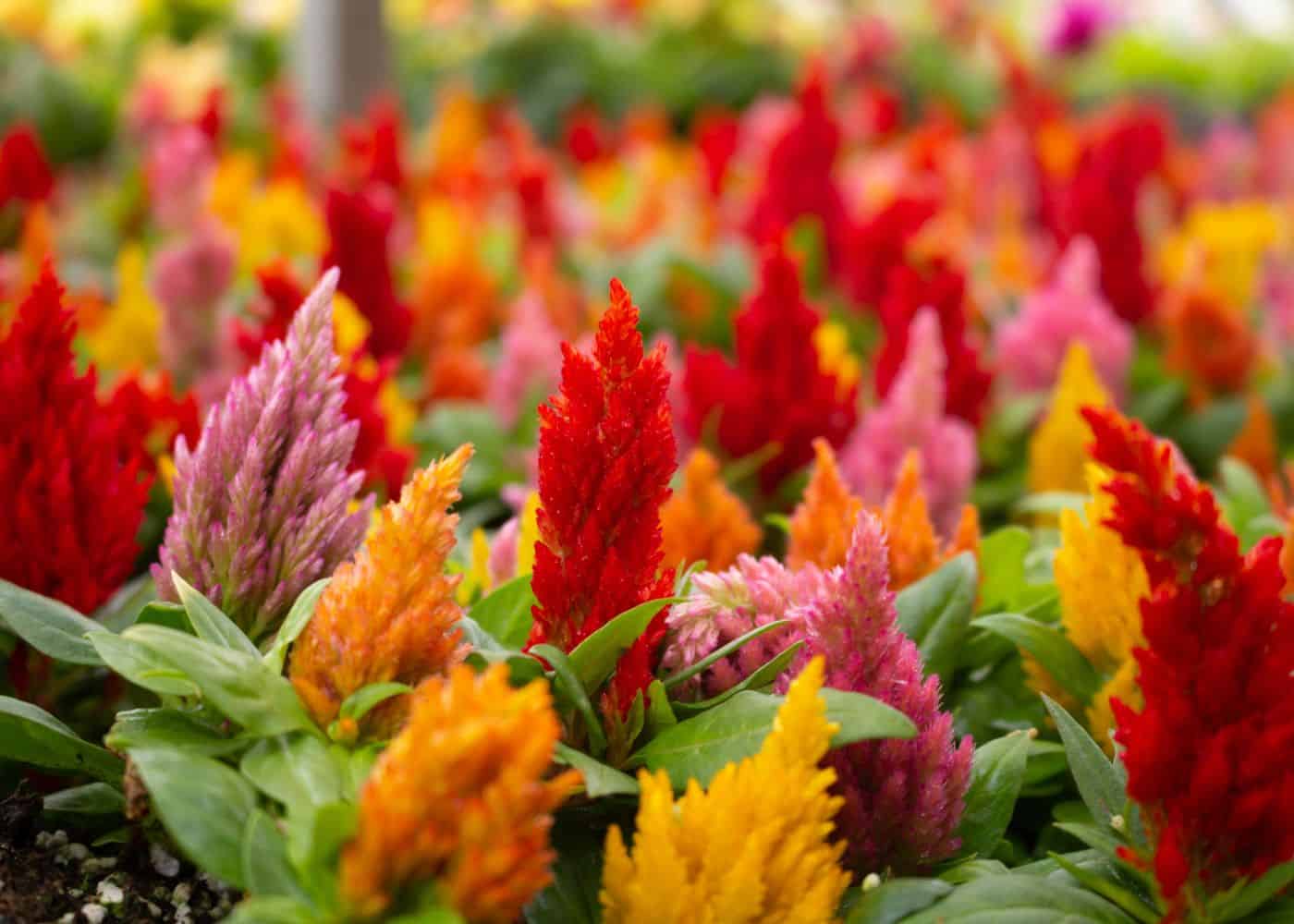
7. Celosia
Celosia, with its vivid, flame-like blooms, is a striking addition to the fall garden. The flower heads come in a variety of shapes including plumes, spikes, and combs, adding an element of architectural interest to your outdoor space. Whether in vibrant shades of red, orange, yellow, or even pink and purple, celosia’s eye-catching colors and unique textures make it a standout in fall-themed floral arrangements and garden beds alike.
Popular cultivars of celosia include the ‘Cristata’ group known for their brain-like, coral-shaped flower heads, and the ‘Plumosa’ group, which has feathery, plume-like blooms. Celosia prefers full sun and well-drained soil, and it’s relatively drought-tolerant compared to other flowering plants. Because of its tolerance for less-than-ideal soil conditions, including poor, sandy, and dry soils, celosia is an excellent choice for gardeners looking for low-maintenance yet high-impact plants. It’s important to avoid overwatering as celosia is prone to root rot in waterlogged conditions.
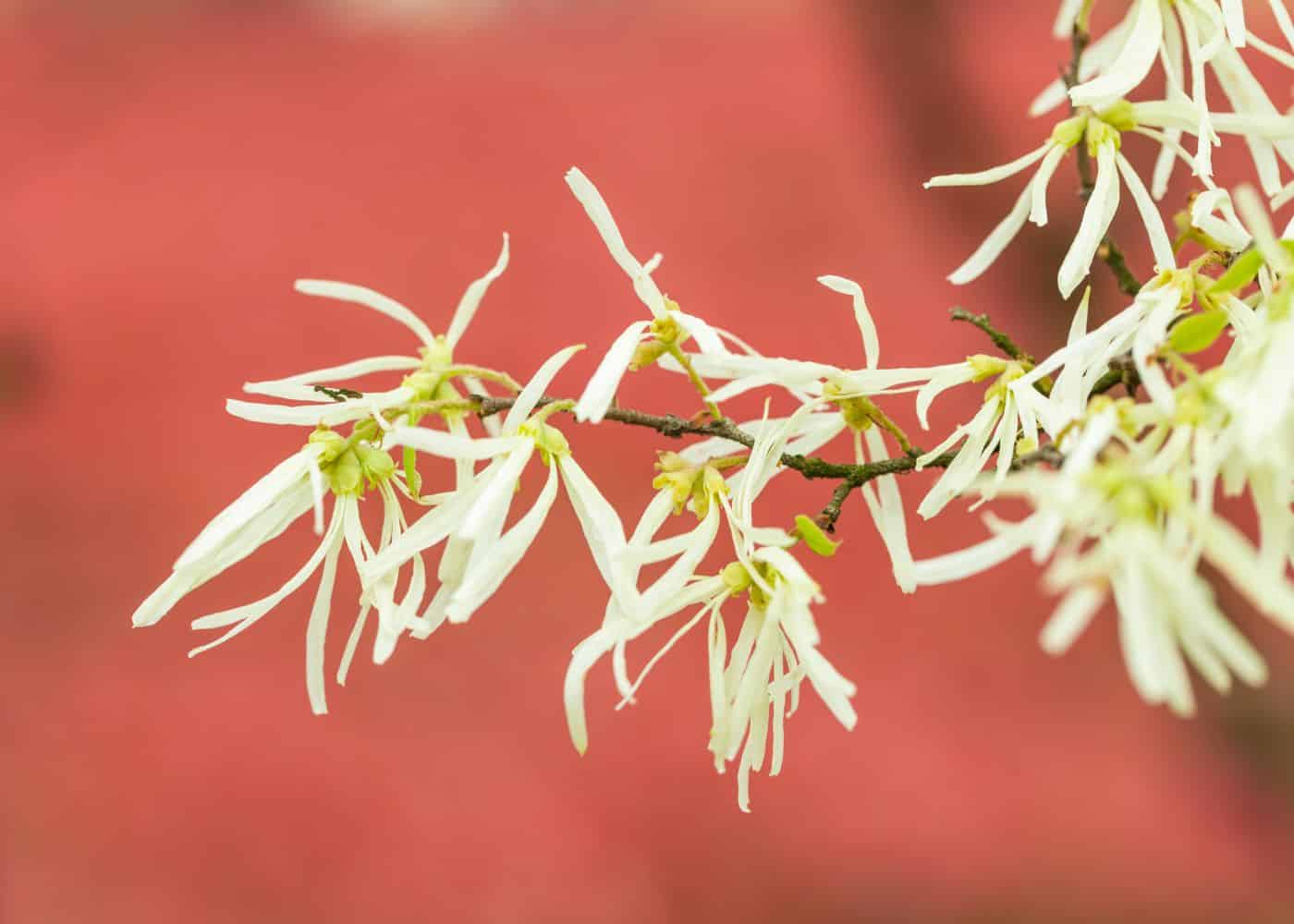
8. Witch hazel
Witch hazel is a unique flowering shrub that provides a burst of color in the fall and sometimes even into the winter when most other plants have gone dormant. The plant produces fragrant, ribbon-like petals in shades of yellow, orange, or red, which are particularly striking against its backdrop of foliage that also turns color in the fall. Witch hazel is valued for its late-season blooms and use in skin-care products.
Popular cultivars of witch hazel include ‘Arnold Promise,’ which offers bright yellow flowers, and ‘Jelena,’ known for its coppery orange blooms. Ideally, witch hazel should be planted in well-drained, loamy soil with a slightly acidic to neutral pH range. Although it can tolerate partial shade, planting it in full sun will encourage more abundant flowering. The plant is relatively low-maintenance, requiring minimal pruning and being largely resistant to most pests and diseases. Witch hazel is an excellent choice for adding late-season interest to your garden, particularly in borders or as a specimen plant.
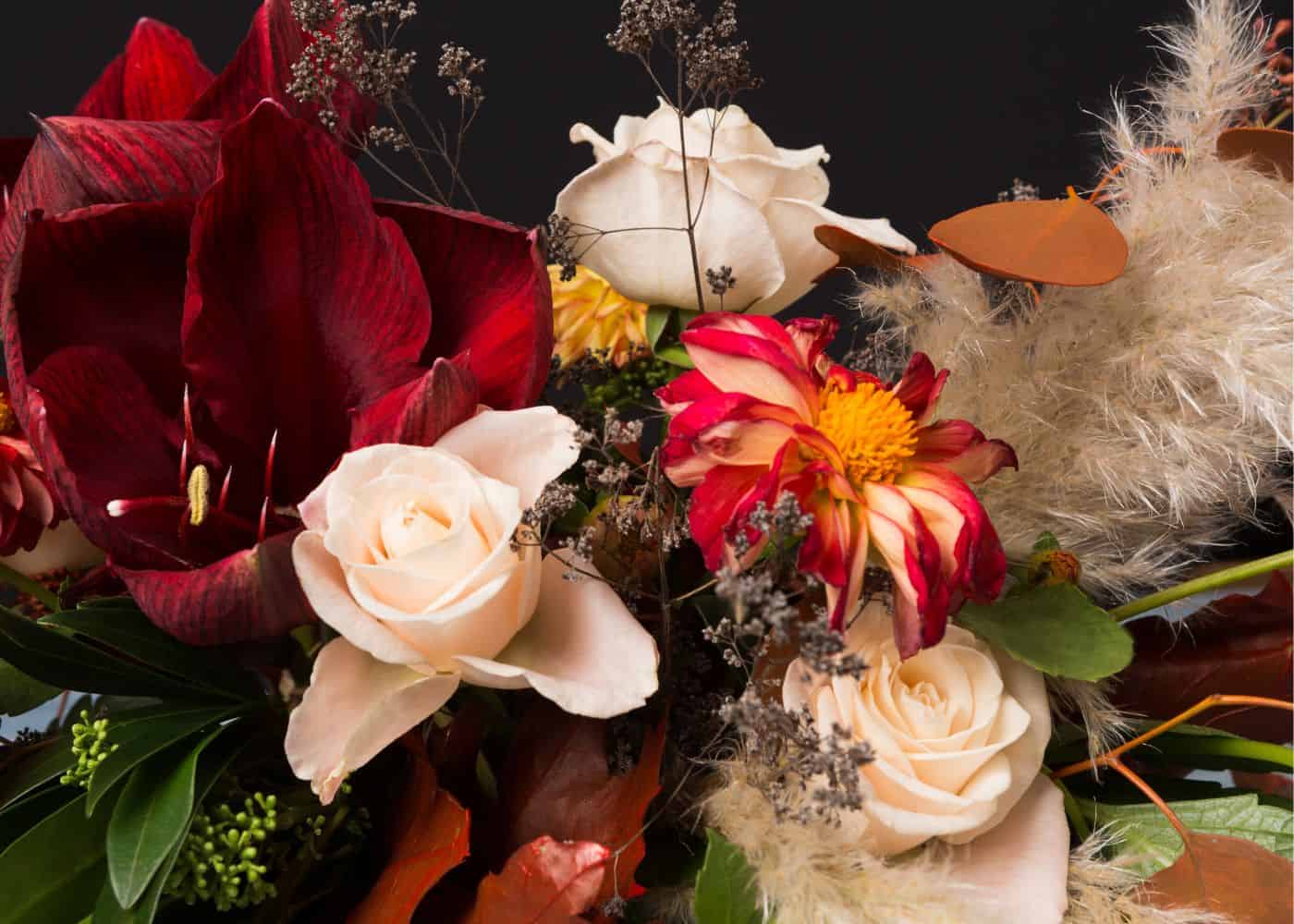
9. Roses
Roses are timeless classics in any garden, and their autumnal spectrum featuring yellows, oranges, and reds adds a touch of romantic warmth to the cooling fall season. Garden roses in these colors not only offer a rich palette that complements the changing foliage but also often have strong fragrances that can fill the garden with a delightful aroma. The blossoms can range from simple, single-petal varieties to opulent, multi-petal blooms, giving gardeners a wide array of options to suit their aesthetic preferences.
Popular garden rose cultivars that shine in autumnal hues include ‘Tequila Sunrise’ with its gradients of yellow and red, ‘Julia Child,’ a buttery yellow floribunda, and ‘Hot Cocoa,’ which flaunts smoky orange-red blossoms. Roses prefer well-drained soil rich in organic matter and benefit from a sunny location that receives at least six hours of direct sunlight per day. They are heavy feeders, so a balanced fertilizer designed specifically for roses can help them maintain vigorous growth and prolific blooming. Autumn is a great time to enjoy these warm-hued roses as they often continue to bloom until the first hard frost, extending the garden’s season of color.

10. Rose hips
Rose hips, the fruit of the rose plant, come into their own in the fall, adding a unique and vivid aspect to the garden. After the rose’s petals fall, the hips begin to form, offering ornamental value with their bright shades of red, orange, and even dark purple. The presence of rose hips can extend the visual interest of your rose bushes well into the colder months, providing an autumnal counterpoint to the garden’s shifting palette.
Several rose varieties are known for producing especially attractive or abundant hips, including Rosa rugosa, known for its large, tomato-like hips, and the Dog Rose (Rosa canina), which produces smaller, more clustered fruit. Rose hips prefer the same conditions as rose flowers: well-drained soil, six to eight hours of sunlight, and regular watering. However, it’s crucial to avoid deadheading the spent flowers late in the season if you want to encourage hip formation. As a bonus, rose hips can also be harvested for teas or jellies, making them a versatile addition to the autumn garden.

11. Nasturtium
Nasturtiums are delightful annuals that add vibrant color and versatility to fall gardens. Their flowers come in warm hues of red, orange, and yellow, and they have rounded, shield-like leaves that create a lush backdrop for the blooms. Nasturtiums not only brighten up garden spaces but are also edible; both the flowers and leaves have a peppery taste and can be used in salads or as garnishes. They make excellent choices for borders, hanging baskets, or even as ground covers, filling in spaces with a splash of autumnal color.
Popular nasturtium cultivars include ‘Empress of India,’ known for its deep red flowers and dark foliage, and ‘Alaska,’ which features variegated leaves. Nasturtiums thrive in full sun but can tolerate partial shade. Interestingly, they are one of the few plants that actually prefer poor, well-drained soil, as overly fertile soil can result in lush foliage but fewer blooms. These plants are generally low-maintenance, requiring little more than regular watering. They are also relatively pest-resistant, though they are sometimes used as a ‘sacrifice’ plant in vegetable gardens to attract aphids away from more valuable crops.
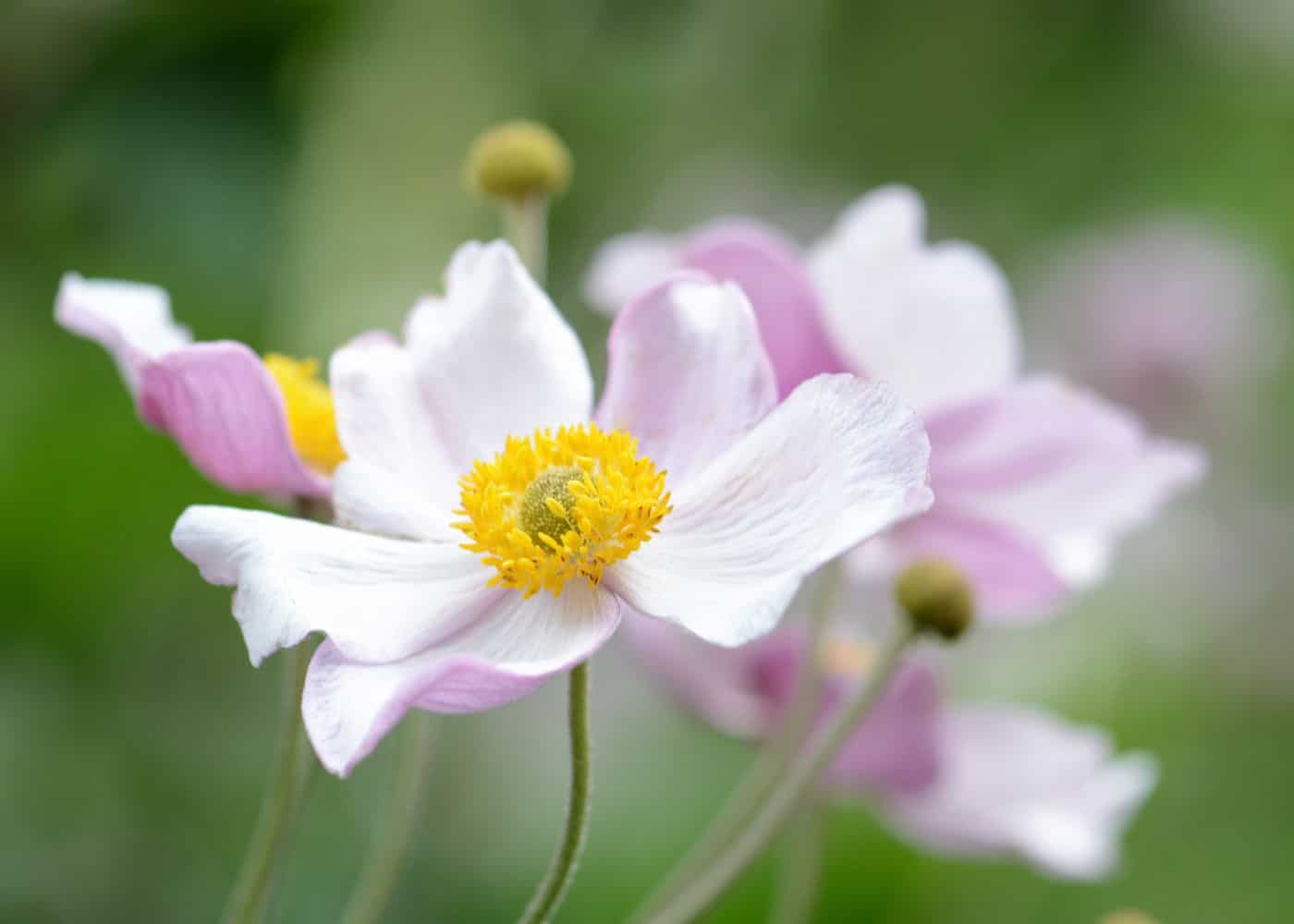
12. Anemones
Anemones, often referred to as “windflowers,” bring a graceful elegance to fall gardens with their delicate petals and slender stems. Typically blooming in late summer through fall, these perennials offer an array of colors including white, pink, and purple, and serve as a stunning contrast to the more robust textures of autumn foliage. The flower consists of a circular arrangement of petals surrounding a central disk, creating a simple yet captivating visual display that sways gently in the breeze.
Popular fall-blooming anemone cultivars include Anemone hupehensis ‘September Charm,’ which showcases rose-pink flowers, and Anemone x hybrida ‘Honorine Jobert,’ known for its pristine white blossoms. These plants prefer well-drained soil rich in organic matter and do well in partial shade to full sun. While they can tolerate a variety of soil types, they thrive best in moist conditions. Once established, anemones are relatively low maintenance but may require staking if they reach taller heights. Their tall, elegant stems also make them excellent candidates for cut flower arrangements, allowing you to bring a touch of autumnal beauty indoors.

13. Coreopsis
Coreopsis is a cheerful perennial that brings bursts of golden-yellow color to the fall garden. With its daisy-like petals and rich, warm hues, coreopsis offers an uplifting presence amidst the often subdued tones of autumn foliage. It’s an exceptionally versatile flower that comes in various shades, including pink and red, although yellow remains the most traditional and popular. The plant typically stands about 18 to 24 inches tall, making it suitable for both borders and container gardens.
Popular cultivars include Coreopsis grandiflora ‘Early Sunrise,’ which has semi-double golden blooms, and Coreopsis verticillata ‘Moonbeam,’ known for its pale yellow flowers. Coreopsis thrives in full sun and well-drained soil but is remarkably resilient and can tolerate poor, sandy, and drought-prone conditions. This low-maintenance characteristic makes it a favorite among both novice and experienced gardeners. To encourage a longer blooming season, deadheading spent flowers is recommended. Its sunny disposition, minimal care requirements, and long-lasting blooms make Coreopsis a fall garden essential.
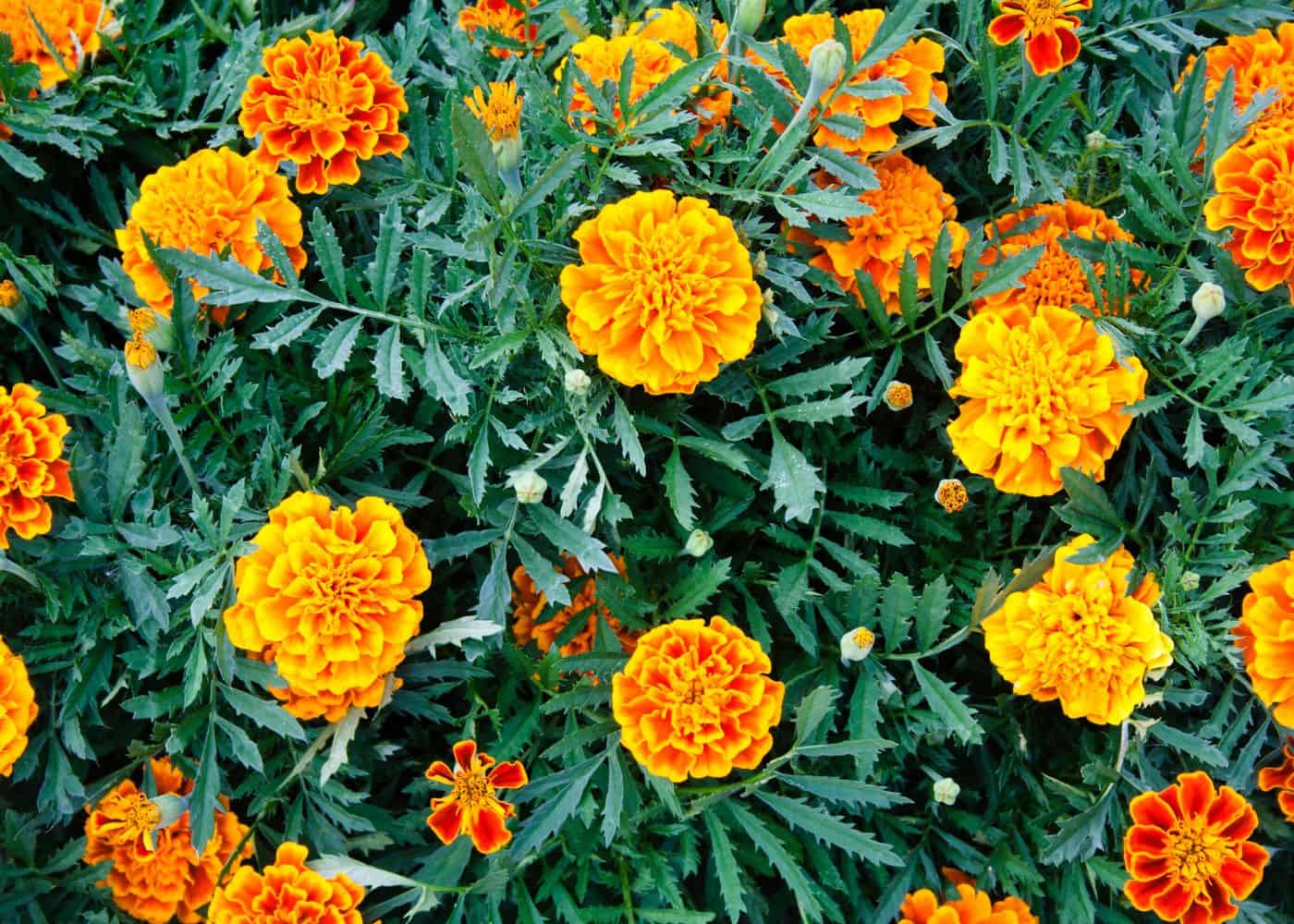
14. Marigold
Marigolds are a popular choice for adding warm, autumnal colors to the garden. Known for their rich hues ranging from bright yellows and golds to deep oranges and reds, these flowers offer cheerful, pom-pom-like blooms that contrast beautifully with the more subdued tones of fall. With heights varying from 6 to 36 inches depending on the variety, marigolds are versatile enough to be planted in garden beds, borders, or containers. They are particularly popular in fall-themed displays and as companion plants in vegetable gardens, where they help deter certain pests.
Popular cultivars of marigold include the French Marigold (Tagetes patula) known for its intricate, frilly flowers, and the African Marigold (Tagetes erecta), which offers larger, more robust blooms. These plants prefer a sunny location and are relatively drought-tolerant, although they perform best with consistent moisture. Well-drained soil enriched with organic matter will encourage more vigorous growth and flowering. One of the advantages of planting marigolds is their hardiness and ease of care, making them ideal for both novice and experienced gardeners looking to extend the bloom season into the fall.
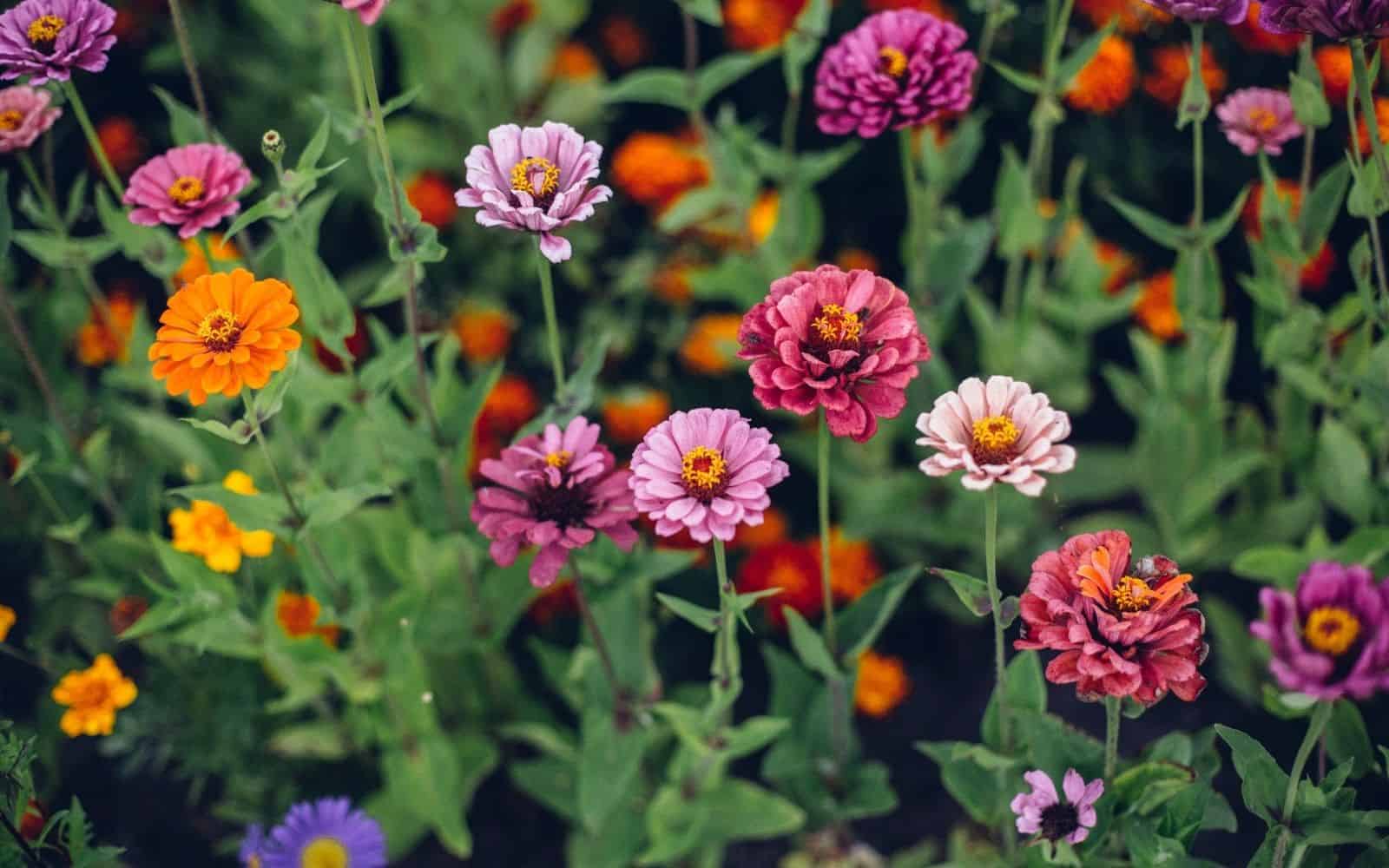
15. Zinnia
Zinnias are a beloved addition to the fall garden, captivating gardeners and pollinators alike with their vibrant, multi-petaled blooms. Known for their wide range of colors including red, pink, orange, yellow, and even green, zinnias offer a splash of color that lasts until the first frost. With varying heights ranging from 6 inches for dwarf varieties to over 3 feet for taller types, they are as versatile as they are colorful, fitting into garden beds, borders, and containers seamlessly.
Some of the popular cultivars are Zinnia elegans ‘Queen Red Lime’ with its unique lime-tinted red flowers, and Zinnia ‘Profusion,’ which is celebrated for its disease resistance and continuous bloom. Zinnias love a sunny spot and prefer well-drained soil. They are somewhat drought-tolerant, but they will produce their best blooms with regular watering and feeding. Given their preference for warm conditions and their relative ease of care, zinnias are an excellent choice for those looking to extend their garden’s color palette into the fall season.


